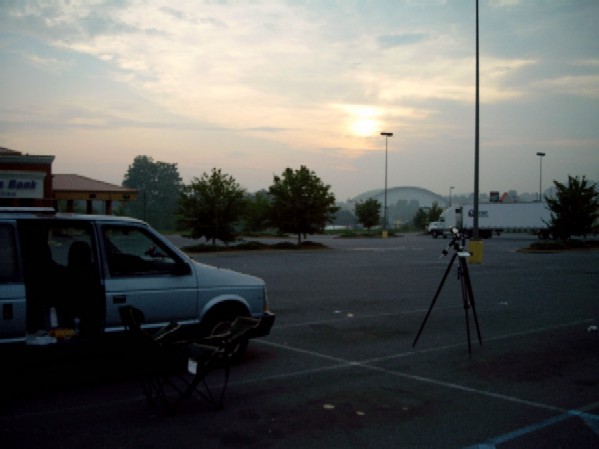
The ETSU Venus "expedition" to the Kroger parking lot in Johnson City, TN.

Johannes Kepler, the first person to give an accurate way to qualitatively predict the location of planets, predicted a transit of Mercury on November 7, 1631 and a transit of Venus on December 6, 1631. The Mercury transit was observed by the French astronomer Pierre Gassendi, but the Venus transit was not visible in Europe and presumably went unobserved. Before the 1600's, an accurate method of predicting such events was not available and presumably no such events were observed. After all, an Earth centered model of the solar system was assumed and such an event would not have even been suggested before the 1600's (at least not in Catholic Europe).
The second Venus transit in the pairing occured on December 4, 1639. Though Kepler's math failed to predict this event, the British mathematician Jeremiah Horrocks successfully predicted the event and observed about a half hour of it. This makes Horrocks the first person known in history to observe such an event. Only one other person, William Crabtree a friend of Horrocks', is known to have seen the event.
The audience grew for the June 6, 1761 and June 3-4, 1769 transits. Weather conditions, political conditions, and an atmospherically induced "halo" around Venus squelched plans for precise timings of the transit. In 1769, the transit was observed by Captain James Cook near Tahiti. The transit was also observed by David Rittenhouse in Philadelphia, PA. Subsequent computations based on these observations estimated the distance from Earth to the Sun (called an "astronomical unit" and a fundamental unit of cosmic measurement) as 95,280,000 miles (now known to be closer to 93,000,000 miles). This estimate was 2.5% off.
The next pair of Venus transits occured on December 9, 1874 and December 6, 1882. During the 1874 transit, observations narrowed the estimate of the astronomical unit to within 0.2% of its actual value. As a consequence, the 1882 transit was not of such great scientific importance. It was, instead, a matter of popular media interest. Again this year, we the public have the opportunity to observe a truly rare event. Though not of great scientific interest, we can still enjoy the rarety of this transit. NO ONE ALIVE TODAY has seen such an event!
This is only the sixth such event which humans have known to observe before-hand! For details of this transit, see the "Sky and Telescope" website: http://skyandtelescope.com/observing/objects/article_1258_1.asp
For images of the event, see Sky and Telescope, in particular: http://skyandtelescope.com/news/article_1283_1.asp.
Return to Bob Gardner's webpage.